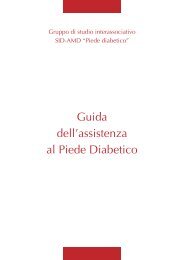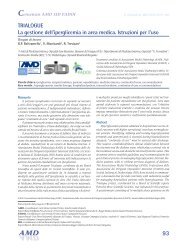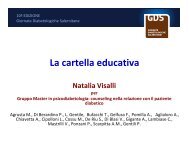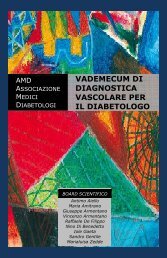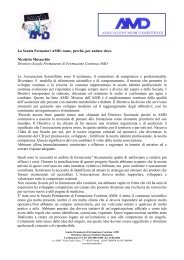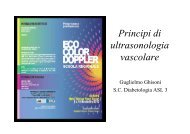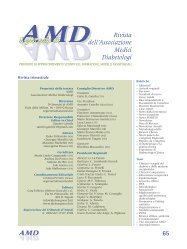Numero 3, Volume 15 - luglio 2012 - Nuova Serie - AMD
Numero 3, Volume 15 - luglio 2012 - Nuova Serie - AMD
Numero 3, Volume 15 - luglio 2012 - Nuova Serie - AMD
Create successful ePaper yourself
Turn your PDF publications into a flip-book with our unique Google optimized e-Paper software.
Esperienze di Diabetologia Clinica<br />
2. Tuchman LK, Slap GB, Britto MT. Transition to adult care:<br />
experiences and expectations of adolescents with a chronic<br />
illness. Child Care Health Dev 2008; 34: 557-63.<br />
3. Songini M. Transfer of IDDM patients from paediatric to<br />
adult diabetologist, Theoretical and pratical aspects of the<br />
treatment of diabetic children – 5° International ISPAD<br />
Course, March 11/18, 1995,pag. 207-211.<br />
4. Fleming E et al. The transition of adolescents with diabetes<br />
from the children’s health care service into the adult<br />
health care service: a review the literature J Clin. Nursing<br />
2002; 11, 560-567.<br />
5. Albani I. Passaggio dell’adolescente con diabete mellito<br />
insulino-dipendente dal pediatra al diabetologo dell’adulto<br />
(PANDA) Il Diabete 1997, dicembre:206-212.<br />
6. Consensus Guidelines 2000 - ISPAD Consensus Guidelines<br />
for the Management of Type 1 Diabetes Mellitus in<br />
Children and Adolescents, eds. Peter Swift, © Copyright<br />
2000 by International Society for Pediatric and Adolescent<br />
Diabetes.<br />
7. Bryden SK, Peveler RC, Stein A, Neil A, Mayou RA, Dunger<br />
DB. Clinical and Psychological Course of Diabetes<br />
from Adolescence to Young Adulthood. A longitudinal<br />
cohort study Diabetes Care 2001; 24:<strong>15</strong>36-<strong>15</strong>40.<br />
8. American Academy of Pediatrics-American Academy of<br />
Family Physicians-Americal College of Physicians-American<br />
Society of Internal Medicine. A Consensus Statement<br />
on Health Care Transitions for Young Adults with Special<br />
Health Care Needs Pediatrics, 2002;110:1304-1306.<br />
9. Scal P. Transition for Youth with chronic conditions:<br />
Primary Care Physicians’ Approaches. Pediatrics<br />
2002;110:13<strong>15</strong>-1321.<br />
10. Reiss J, Gibson R. Health Care Transition: Destinations<br />
Unknown. Pediatrics 2002;110:1307-1314.<br />
11. McGill M. How do we organize smooth, effective transfer<br />
from Paediatric to Adult Diabetes Care? Horm Res<br />
2002;57(1):66-68.<br />
12. Transition to adult health care for adolescents and young<br />
adults with chronic conditions. Journal of Adolescent Health<br />
2003;33:309-311.<br />
13. Reiss JG, Gibson RW, Walker LR. Health care transition:<br />
youth, family and provider perspectives Pediatrics 2005;<br />
1<strong>15</strong>:112-120.<br />
14. Gentili P, Brugnoni M, Burla F. Le motivazioni dei giovani<br />
italiani affetti da diabete di tipo 1 a trasferirsi dal<br />
Centro di Diabetologia pediatrica al Centro di Diabetologia<br />
dell’adulto. Difesa Sociale, 2004; Vol LXXXIII, n 4:<br />
27-44.<br />
<strong>15</strong>. Anderson BJ, Wolpert HA. A developmental perspective<br />
on the challenges of diabetes education and care during<br />
the young adult period Patient Education and Counseling<br />
2004; 53:347-352.<br />
16. Silverstein J, Klingensmith G, Copeland K, Ploinick L,<br />
Kaufman F, Laffel L, Deeb L, Grey M, Anderson B, Holzmeister<br />
LA, Clark N. Care of children and adolescents<br />
with type 1 diabetes Diabetes Care 2005; 28:186-205.<br />
17. Adamo SMG et al. Il Diabete in Età Evolutiva: un approccio<br />
integrato, La Città del Sole, Napoli, 1995; 61-76.<br />
18. Cadario F, Prodam F, Bellone S, Trada M, Binotti M, Trada<br />
M, et al. Transition process of patients with type 1 diabetes<br />
(T1DM) from paediatric to the adult health care service:<br />
a hospital-based approach. Clin Endocrinol. 2009;71:346-<br />
50.<br />
19. Gruppo di Studio SIEDP, <strong>AMD</strong>, SID. Transizione dei giovani<br />
con diabete mellito verso l’età adulta Il Giornale di<br />
<strong>AMD</strong> 2010; 13:<strong>15</strong>9-168.<br />
20. Vanelli M, Caronna S, Adinolfi B, Chiari G, Gugliotta M,<br />
Arsenio L. Effectiveness of an uninterrupted procedure to<br />
transfer adolescents with type 1 diabetes from the paediatric<br />
to the adult clinic held in the same hospital: eightyear<br />
experience with the Parma protocol. Diabetes Nutr<br />
Metab 2004;17:304-8.<br />
21. Busse-Voigt FP et al. Building bridges during transition of pa-<br />
<strong>AMD</strong><br />
Il Giornale di <strong>AMD</strong> <strong>2012</strong>;<strong>15</strong>:196-207<br />
tients with type 1 diabetes. adult medical and pediatric point<br />
of views. Internist (Berl). 2009 50:1194, 1196, 1198 passim.<br />
22. Di Berardino P, Gentili P, Bufacchi T, Agrusta M. Manuale<br />
di Formazione all’intervento psicopedagogico in Diabetologia<br />
Pacini Editore, 2008.<br />
23. Engel GL. The clinical application of biopsychosocial model.<br />
Am J of Psychiatry, 1980.<br />
24. Rogers CR. La terapia centrata sul cliente: teoria e ricerca.<br />
Ed. Martinelli, Firenze 1994.<br />
25. Gordon T. Genitori efficaci. Educare figli responsabili.<br />
Edizioni la meridiana, Molfetta (BA), 2a Ed., 1997.<br />
26. Assal JF, Golay A, Jacquement S. L’educazione terapeutica<br />
del paziente. Considerazioni sui metodi della medicina<br />
convenzionale L’arco di Giano 18:<strong>15</strong>-28,1998.<br />
27. Assal JP et al. Revisiting the appoach to treatment of long<br />
term illness: from the acute to the chronic state. A need for<br />
educational and managerial skills for long-term follow-up.<br />
Patient Education and Counseling 37:99-111,1999.<br />
28. Gautier JF, Choukem SP et al. Transferring type 1 diabetic<br />
patients from pediatric to adult diabetes care: can we do<br />
better? Horm Res 2007;67:139-141.<br />
Ambulatorio per la medicazione del piede<br />
diabetico: 2005-2011: sei anni di esperienza<br />
multidisciplinare e interdipartimentale in un<br />
ospedale di distretto<br />
M. Michelini 1 , R. Trianni 1 , A. Zollino 4 , A.<br />
lambertini 3 , F. Borghi 1 , l. Finardi 1 , E. Manicardi<br />
1 M. Bongiorno 5 , F. Dell’Oste 5 , V. Manicardi<br />
2<br />
massimo.michelini@ausl.re.it<br />
1 Servizio di Diabetologia, 2 Dipartimento Internistico,<br />
3 Ortopedia, 4 Lungodegenza, 5 Specialistica Ambulatoriale e<br />
Servizio Infermieristico Domiciliare del Dipartimento di Cure Primarie,<br />
Ospedale E. Franchini di Montecchio Emilia, AUSL di Reggio Emilia<br />
Parole chiave: Diabete mellito, Piede diabetico, Team multidisciplinare,<br />
Diversi livelli d’intensità di cura<br />
Key words: Diabetes mellitus, Diabetic foot, Multi-disciplinary<br />
team, Different levels of care intensity<br />
Riassunto<br />
Le lesioni ulcerative del piede sono una complicanza frequente<br />
nella vita del diabetico, ed i pazienti diabetici sono oltre<br />
la metà degli amputati agli arti inferiori; in un piccolo ospedale<br />
di Distretto, tra limitate risorse economiche ed umane e<br />
bisogni del paziente, dal 2005 è stato attivato a Montecchio,<br />
AUSL di Reggio Emilia, un ambulatorio per la medicazione<br />
del piede diabetico; la sua organizzazione, multi professionale,<br />
multidisciplinare, ed interdipartimentale ha consentito di<br />
poter costruire un percorso che rappresenta un punto di riferimento<br />
per i pazienti, con riduzione dei tempi di accesso alla<br />
medicazione, garantisce continuità assistenziale tra ospedale e<br />
territorio, consente di poter usufruire, nell’ambito del Dipartimento<br />
Internistico, di diversi livelli di intensità di cura e rappresenta<br />
la base di partenza per futura costruzione di modello<br />
hub and spoke con strutture di terzo livello dedicate alla cura<br />
del piede diabetico.<br />
201



